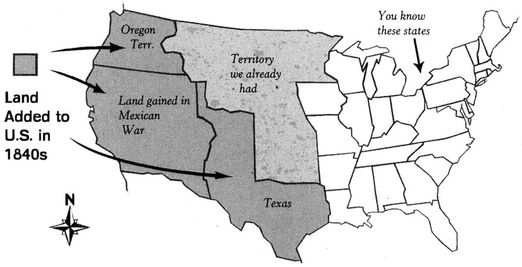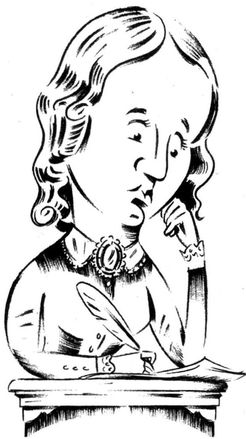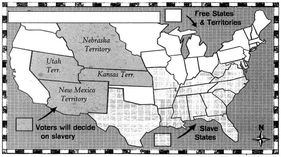Two Miserable Presidents (2 page)
Read Two Miserable Presidents Online
Authors: Steve Sheinkin

F
rederick Douglass found another way to battle slavery. He used his house as part of the Underground Railroad, a secret system of routes used by people escaping from slavery. Houses like Douglass's were known as “stations”âplaces where runaway slaves could rest and hide during the day. Daring “conductors,” both black and white, guided escaping slaves from station to station all the way to Canada, where slavery was illegal.
rederick Douglass found another way to battle slavery. He used his house as part of the Underground Railroad, a secret system of routes used by people escaping from slavery. Houses like Douglass's were known as “stations”âplaces where runaway slaves could rest and hide during the day. Daring “conductors,” both black and white, guided escaping slaves from station to station all the way to Canada, where slavery was illegal.
The most famous Underground Railroad conductor was a fivefoot-tall woman named Harriet Tubman. Tubman grew up enslaved in Maryland, suffering beatings and whippings that left permanent scars on her body. In 1849, when she was twenty-nine, she found out she was about to be sold. She set off on a hundred-mile walk to freedom, helped along by Underground Railroad conductors who guided her to Pennsylvania.
“When I found I had crossed that line, I looked at my hands to see if I was the same person,” she said. “I was free, but there was no one to welcome me to the land of freedom.” She was thinking of her familyâthey were all still living in slavery.
“I was free, and they should be free.” Tubman said. “I would make a home in the North and bring them there.”
Tubman spent the next ten years planning and carrying out at least thirteen rescue missions, guiding about three hundred people to freedom. Can you guess why she liked to operate in winter? The nights were longer in winter, and it was safer to travel in darkness. Safer not only for escaping slaves, but for Tubman too. Angry slave owners were offering a $40,000 reward for her capture.
Only a small minority of Northerners were abolitionists or Underground Railroad conductors. But their work was causing growing anger in the South. Slave owners saw it like this:
Slavery is perfectly legal in the South, and we have invested our money in slaves. Slaves are our legal property. These abolitionists are trying to steal our property. They're trying to make us poor! How would they like it if we came up north and took away their farms and factories?
Slavery is perfectly legal in the South, and we have invested our money in slaves. Slaves are our legal property. These abolitionists are trying to steal our property. They're trying to make us poor! How would they like it if we came up north and took away their farms and factories?
You might answer:
But you have no right to own slaves in the first place!
But for now we're not talking about right and wrong. We're just trying to figure out how Northerners and Southerners got angry enough at each other to rip the country in two.
But you have no right to own slaves in the first place!
But for now we're not talking about right and wrong. We're just trying to figure out how Northerners and Southerners got angry enough at each other to rip the country in two.
S
peaking of getting angry, the North and South soon had something else to fight overâmore land. By 1848 the United States looked like this:
peaking of getting angry, the North and South soon had something else to fight overâmore land. By 1848 the United States looked like this:

Then gold was discovered in California and thousands of miners raced west, dreaming of quick riches. Suddenly California had enough people to become a stateâand it wanted to enter the Union as a free state.
At this time there were thirty states: fifteen free states and fifteen slave states. Was California going to upset this careful balance? Not if Southern leaders could help it. Senator Jefferson Davis of Mississippi summed up Southern fears: “For the first time, we are about to permanently destroy the balance of power between the sections.”
Some Southern members of Congress began to talk openly of “disunion”âthe breakup of the United States.
H
old on
, said Senator Henry Clay of Kentucky,
we canwork this
out. Clay offered a compromise designed to keep the peace between North and South. The two most important points were these:
old on
, said Senator Henry Clay of Kentucky,
we canwork this
out. Clay offered a compromise designed to keep the peace between North and South. The two most important points were these:
California will be admitted to the Union as a free state.
Congress will pass the Fugitive Slave Act, which will make it easier for slave owners to catch escaping slaves.

By 1850, though, a lot of people didn't feel like compromising anymore. Senator John C. Calhoun from South Carolina declared that the Union could be saved only if the North met Southern demands: stop helping escaped slaves, stop the abolitionist movement, and promise to keep the balance between free states and slave states. He was too sick to give a long speech (he actually died a month later), but he sat in the Senate chamber, a blanket over his legs, while a fellow senator read his emotional words: “The South asks for justice, simple justice, and less she ought not to take.”
Senator William Seward of New York rejected Calhoun's demands. Slavery was going to end whether Calhoun liked it or not, Seward insisted. And there was no way he was going to allow slavery to spread into California or any other new territory. “I cannot consent to introduce slavery into any part of this continent which is now exempt from what seems to me so great an evil,” Seward said.
This was all part of a months-long argument that included a few fistfights on the floor of Congress. At one point Senator Henry Foote of Mississippi actually pulled out a pistol and aimed it at Missouri senator Thomas Hart Benton.
“I have no pistols!” Benton shouted. “Let him fire! Stand out of the way and let the assassin fire!”
Foote didn't fire.
In the end, most members of Congress agreed with Senator Daniel Webster of Massachusetts. Webster spoke passionately in favor of keeping the peace between North and South:
Daniel Webster

“I wish to speak today, not as a Massachusetts man, nor as a Northern man, but as an American ⦠I speak today for the preservation of the Union.”
Congress eventually agreed to the compromise outlined by Henry Clayâthe Compromise of 1850, as it was called. “The Union is saved!” shouted people in the streets of Washington, D.C.
Unfortunately for the Union, the Compromise of 1850 made people madder than ever.
According to the tough new Fugitive Slave Act, any African American suspected of being a fugitive slave could be captured and dragged before a judge. The accused person had no right to testify, and no right to a trial by jury. The judge simply decided if this person was really a runaway slave. The judge got five dollars if he set the person free, and ten dollars if he sent the person into slavery!
Many Northerners, even if they had not been abolitionists before, howled in anger at what they saw as a cruel and unjust law. And escaped slaves living in the North knew they were in serious danger. Just ask Henry Brown.
A year before, Brown had escaped from slavery by packing himself into a small wooden crate in Richmond, Virginia, and instructing his friends to mail him to an abolitionist office in Philadelphia. The friends wrote “This side up, with care” on the crate. But the people handling the box didn't pay much attention, and Brown spent several miserable hours upside down. After a twenty-six-hour train ride, Brown, dying of heat and thirst, heard people prying open the box. He had no way of knowing where he was. So as the top of the crate was lifted, it was with tremendous joy that he looked up and saw four fairly confused Philadelphia abolitionists staring down at him. Brown stood up and reached out his hand and said, “Good morning, gentlemen.
Soon after passage of the Fugitive Slave Act, Henry Brown (now famous as Henry “Box” Brown) was attacked and nearly captured in Providence, Rhode Island. He managed to beat up the kidnappers, but he knew he could be grabbed at any moment. He got on a ship and sailed to Britain.
H
enry Brown was luckyâmost fugitives didn't have rich friends to buy them tickets to Europe. Slave catchers stalked the streets of Northern cities, kidnapping escaped slaves and sometimes even African Americans born free in the North.
enry Brown was luckyâmost fugitives didn't have rich friends to buy them tickets to Europe. Slave catchers stalked the streets of Northern cities, kidnapping escaped slaves and sometimes even African Americans born free in the North.
A writer named Harriet Beecher Stowe was so mad, she had to do something. But what? Her sister-in-law gave her an idea: “Hattie, if I could use a pen as you can, I would write something that will make this whole nation feel what an accursed thing slavery is.”
Stowe began writing a book, working at night (after putting her six children to bed) at the kitchen table in her family's house in Maine.
In her novel, which she called
Uncle Tom's Cabin,
Stowe tried to make readers feel the horrors of slavery. She forced parents to imagine what it would be like to see a slave trader coming to buy their only child.
In her novel, which she called
Uncle Tom's Cabin,
Stowe tried to make readers feel the horrors of slavery. She forced parents to imagine what it would be like to see a slave trader coming to buy their only child.
Harriet Beecher Stowe

“If it were your Harry, mother, or your Willie, that were going to be torn from you by a brutal trader, tomorrow morning,âif you had seen the man, and heard that the papers were signed and delivered, and you had only from twelve o'clock till morning to make good your escape,âhow fast could you walk? How many miles could you make in those few brief hours ⦠?”
Published in 1852,
Uncle Tom's Cabin
broke readers' hearts, inspiring many in the North to hate slavery like never before. Offended Southern writers fired back with books of their own, arguing that slaves in the South were actually well treated and happy. They insisted that Northern factory workers were much worse off than enslaved African Americans.
Uncle Tom's Cabin
broke readers' hearts, inspiring many in the North to hate slavery like never before. Offended Southern writers fired back with books of their own, arguing that slaves in the South were actually well treated and happy. They insisted that Northern factory workers were much worse off than enslaved African Americans.
W
ith tensions between North and South reaching new heights, we now turn back to the most explosive issue: what to do with all that western land?
ith tensions between North and South reaching new heights, we now turn back to the most explosive issue: what to do with all that western land?
Senator Stephen Douglas of Illinois thought it was time to divide the huge Nebraska Territory into smaller territories that could become states. But there was a problem. All this land was north of the line drawn in the Missouri Compromise (see Step 3), so it could only be made into free states. Southern senators would never allow this, Douglas knew.
Douglas proposed a solution: We'll throw out the Missouri Compromise and make a new deal called the Kansas-Nebraska Act. We'll divide the territory in two: Nebraska in the north and Kansas in the south. And we'll let the people who settle in the territories vote on whether or not they want slavery.
Congress passed the Kansas-Nebraska Act in 1854, and President Franklin Pierce signed it into law.
The Kansas-Nebraska Act, 1854

Douglas really thought this would stop the North and South from fighting over slavery in the territories. After all, now it was up to the settlers themselves to decide the slavery question. That was democracy, right? Self-government? Who could be against that?
Actually, lots of people. When Douglas went home to give a speech in Chicago, an angry crowd shouted at him for two solid hours, finally driving him off the stage. In Peoria, Illinois, people were calm enough to listen to Douglas's defense of the Kansas-Nebraska Act. Then a lawyer and former member of Congress named Abraham Lincoln rose to respond. Lincoln was so tall and skinny, people said it looked as if he unfolded as he stood up.
Lincoln launched his attack based on one simple idea: “There can be no moral right in connection with one man's making a slave of another.” Slavery was wrong, he argued, and they should not allow it to spread to new territories. Did white people really have the right to vote on whether or not they could own black people? Was this really self-government?
“When the white man governs himself, that is self-government; but when he governs himself, and also governs another man, that is more than self-governmentâthat is despotism.
1
”
1
”
But whether Lincoln liked it or not, the people of Kansas were going to vote on the slavery question. Which side would win? That would depend on who got there first.
Abraham Lincoln

Other books
Blazing Serious by Viola Grace
A First Family of Tasajara by Harte, Bret
Honey, Baby, Sweetheart by Deb Caletti
Fever by Lauren Destefano
Bloodletting and Miraculous Cures by Vincent Lam
Quarterback's Surprise Baby (Bad Boy Ballers Book 2) by Imani King
Light of the Moon by David James
Rancher Bear: BBW Bear Shifter Romance (Bear Haven Book 2) by Bolryder, Terry
Dinosaur Lake 3: Infestation by Griffith, Kathryn Meyer
